- Python Basic Programs
- Python Program Examples
- Python Print Hello World
- Python Get Input from User
- Python Add Two Numbers
- Add Subtract Multiply Divide
- Python Check Even or Odd
- Python Check Prime or Not
- Python Check Alphabet or Not
- Python Check Vowel or Not
- Python Check Leap Year or Not
- Check Reverse equal Original
- Check Positive Negative Zero
- Python Check Armstrong or Not
- Python Check Palindrome or Not
- Python Check Perfect Number
- Python Find Reverse of Number
- Python Count Digits in Number
- Python Add Digits of Number
- Sum of First and Last Digits
- Python Product of Mid Digits
- Sum of Squares of Digits
- Interchange Digits of Number
- Python Sum of n Numbers
- Python Print ASCII Values
- Python Swap Two Numbers
- Python Swap Two Variables
- Python Fahrenheit to Celsius
- Python Celsius to Fahrenheit
- Python Display Calendar
- Python Days into Years, Weeks
- Find Largest of Two Number
- Find Largest of Three Number
- Python Print Fibonacci Series
- Generate Armstrong Numbers
- Python Make Simple Calculator
- Python Add Binary Numbers
- Binary Number Multiplication
- Python Mathematical Programs
- Find Sum of Natural Numbers
- Find Average of n Numbers
- Python Print Multiplication Table
- Print Table using Recursion
- Python Find Average Percentage
- Python Find Grade of Student
- Find Square Root of Number
- Python Print Prime Numbers
- Find Numbers Divisible by
- Python Find Factors of Number
- Python Find Factorial of a Number
- Python Find HCF & LCM
- Python Kilometres to Miles
- Python Find Area of Square
- Python Find Area of Rectangle
- Python Find Area of Triangle
- Python Find Area of Circle
- Python Find Perimeter of Square
- Find Perimeter of Rectangle
- Python Find Perimeter of Triangle
- Find Circumference of Circle
- Python Simple Interest
- Python Solve Quadratic Equation
- Python Different Set of Operations
- Python Display Powers of 2
- Python Find nCr & nPr
- Python Pattern Programs
- Python Print Pattern Programs
- Python Print Diamond Pattern
- Python Print Floyd's Triangle
- Python Print Pascal's Triangle
- Python List Programs
- Python Count Even/Odd in List
- Python Positive/Negative in List
- Python Even Numbers in List
- Python Odd Numbers in List
- Python Sum of Elements in List
- Sum of Odd/Even Numbers
- Python Element at Even Position
- Python Element at Odd Position
- Python Search Element in List
- Python Largest Number in List
- Python Smallest Number in List
- Python Second Largest in List
- Python Second Smallest in List
- Python Insert Element in List
- Python Delete Element from List
- Python Multiply Numbers in List
- Swap Two Elements in List
- Python 1D Array Program
- Python Linear Search
- Python Binary Search
- Python Insertion Sort
- Python Bubble Sort
- Python Selection Sort
- Remove Duplicates from List
- Python Reverse a List
- Python Merge Two List
- Python Copy a List
- Python Conversion Programs
- Python Decimal to Binary
- Python Decimal to Octal
- Python Decimal to Hexadecimal
- Python Binary to Decimal
- Python Binary to Octal
- Python Binary to Hexadecimal
- Python Octal to Decimal
- Python Octal to Binary
- Python Octal to Hexadecimal
- Python Hexadecimal to Decimal
- Python Hexadecimal to Binary
- Python Hexadecimal to Octal
- Python Matrix Programs
- Python Add Two Matrices
- Python Subtract Two Matrices
- Python Transpose Matrix
- Python Multiply Matrices
- Python String Programs
- Python Print String
- Python Find Length of String
- Python Compare Two Strings
- Python Copy String
- Python Concatenate String
- Python Reverse a String
- Python Swap Two Strings
- Python Uppercase to Lowercase
- Python Lowercase to Uppercase
- Python Check Substring in String
- Python Count Character in String
- Count Repeated Characters
- Python Count Word in Sentence
- Python Count Each Vowels
- Python Capitalize Character
- Python Capitalize Word in String
- Python Smallest/Largest Word
- Remove Spaces from String
- Remove Duplicate Character
- Remove Vowels from String
- Remove Punctuation from String
- Python Remove Word in String
- Python Remove Duplicate Words
- WhiteSpace to Hyphens
- Replace Vowels with Character
- Replace Character in String
- Python Sort String in Alphabetical
- Sort Word in Alphabetical Order
- Extract Number from String
- Python Check Anagram Strings
- Python File Programs
- Python Read a File
- Python Write to File
- Python Append Text to File
- Python Copy Files
- Python Merge Two Files
- Python Counts Characters in File
- Python Count Words in File
- Python File Content in Reverse
- Python Lines Contains String
- Python Delete Line from File
- Python Capitalize Word in File
- Python Replace Text in File
- Replace Specific Line in File
- Python Find Size of File
- Python List Files in Directory
- Python Delete Files
- Python Misc Programs
- Python Reverse a Tuple
- Python Merge Two Dictionary
- Python bytes to String
- Python bytearray to String
- Generate Random Numbers
- Python Print Address of Variable
- Python Print Date and Time
- Python Get IP Address
- Python Shutdown/Restart PC
- Python Tutorial
- Python Tutorial
Python Program to Get Input from User
This article is very important before starting the series of Python programs. Since understanding how to receive inputs from user in Python is required in almost every program.
Therefore I've created some programs here in Python, that shows how inputs gets received from user in many ways. Here are the list of programs on receiving user inputs in Python:
- Simplest Way to Receive User Input
- Get Integer Input from User
- Floating-point Input
- A Character Input
- String Input
- Receive Continuous Inputs
Simplest Way to Receive User Input
To get input from user in Python, you have to use input() function. You can receive any type of input using this function. The question is, write a Python program to receive user input. Here is its answer:
print("Enter anything: ") val = input() print("\nYou've entered:", val)
This program produces the following output initially:
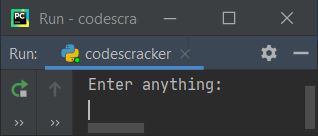
Now type anything say fresherearth and press ENTER key to initialize the entered value to
val variable and then print the value of val variable as output like shown in the snapshot given below:
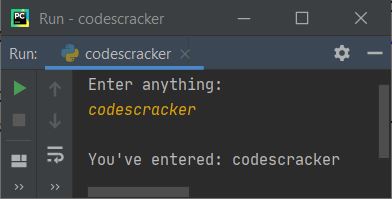
Important - Anything received through input(), treated as a string type value, by default.
Here is another sample run with user input, 235:
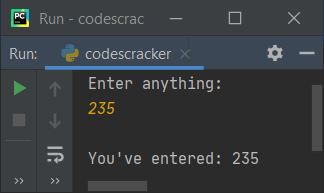
Note - As you can see from above sample output, 235 is a number, but treated as a string like in double quote, that is "235".
To be sure, use the following program to check the type of variable val using type() method.
print("Enter anything: ", end="") val = input() print("\nType of Variable \'val\' =", type(val))
This program produces a output, that equals, Type of Variable 'val' = <class 'str'>, without mattering whatever user enters the value as input. Here is its sample run with same user input as of previous sample run:

As you can see, user enters an integer value, but gets treated as a string type value. Therefore to receive only particular type of value such as integer, string etc. then refer its corresponding programs as given below.
Get Integer Input from User
This program receives only integer type value from user at run-time.
print("Enter an Integer Value: ", end="") val = int(input()) print("\nYou've entered:", val)
Here is its sample run with user input, 54 as an integer value:
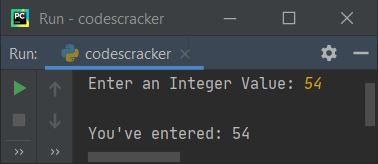
What if User enters an Invalid Input ?
If user enters a value, that does not an integer value, then above program produces an error like shown in the snapshot given below:

to handle invalid inputs using user-defined code, modify previous program with the program given below:
print("Enter an Integer Value: ", end="") try: val = int(input()) print("\nYou've entered:", val) except ValueError: print("\nInvalid Input!")
This program produces following output when user supplies input as python (a string type value):
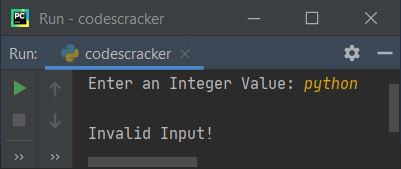
To modify above program, and create a program that continue receiving input from user, until enters a correct value. Then here is the program:
while True: print("Enter an Integer Value: ", end="") try: val = int(input()) break except ValueError: print("\nInvalid Input!..Try Again!\n") continue print("\nYou've entered:", val)
Here is its sample run with user input, hello at first time, 23.43 at second time, 23fresherearth at third time, and 23403 at fourth time (a valid one):
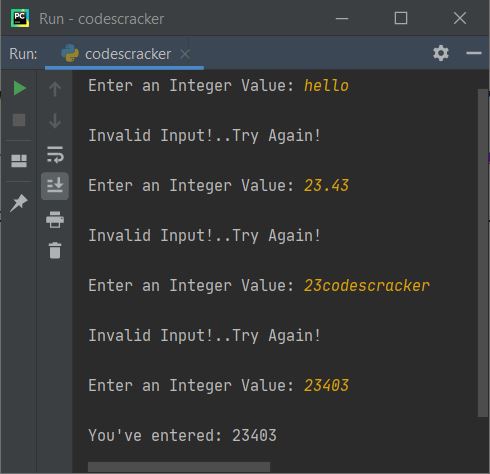
Note - The int() method converts string to an integer type value.
The very first statement inside try, that is:
val = int(input())
states that, the code wants from user to enter an integer value only. But if user enters an invalid input, then the code raises an error (ValueError), and program flow goes to its except's body and prints an error message, whatever user defined or write the message to print.
Now if you want to check the type of variable val, then use following program:
print("Enter an Integer Value: ", end="") val = int(input()) print("\nType of Variable \'val\' =", type(val))
Here is its sample output with integer input say 54:
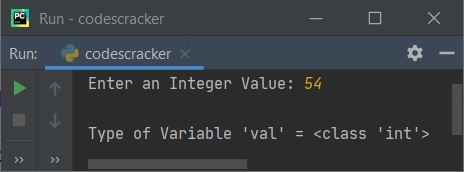
Get Floating-point Input from User
This program receives floating-point value from user. A floating-point value is a value that contains decimal or fractional part. For example, 12.4, 23.43 etc.
print("Enter a Floating-point Value: ", end="") try: val = float(input()) print("\nYou've entered:", val) except ValueError: print("\nInvalid Input!")
Here is its sample run with floating-point input 10.56:
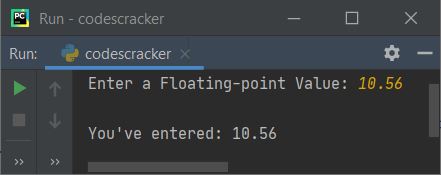
Note - If you enter an integer value, instead of a floating-point, then integer value treated as a floating point value. For example, if user enters 10, then 10 becomes 10.0.
Get a Character Input from User
This program receives a character input from user. A character input means any thing whose length is one.
print("Enter a Floating-point Value: ", end="") val = input() if len(val)==1: print("\nYou've entered:", val) else: print("\nInvalid Input!")
Here is its sample run with character input #:
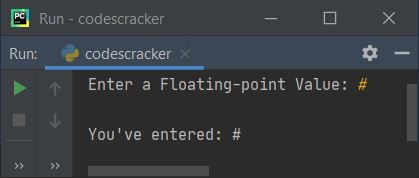
Get String Input from User
To get string input from user, use input() in similar way as used in very first program of this article. The question is, write a Python program to receive string input from user. The answer to this question is given below:
print("Enter String: ", end="") val = input() print("\nYou've entered:", val)
Here is its sample run with string input say Welcome to jobails.com:

How to Take Continuous Input
To receive continuous inputs from user in Python, use list and for loop as shown in the program given below. The question is, write a Python program to receive 10 user inputs using for Loop. Following program is its answer:
print("Enter 10 Values: ") nums = [] for i in range(10): val = input() nums.insert(i, val) print("\nYou've entered:") for i in range(10): print(nums[i], end=" ") print()
Here is its sample run with 10 values say 10, 20, codes, 45.24, 30, 40, cracker, 50, 60, 70:
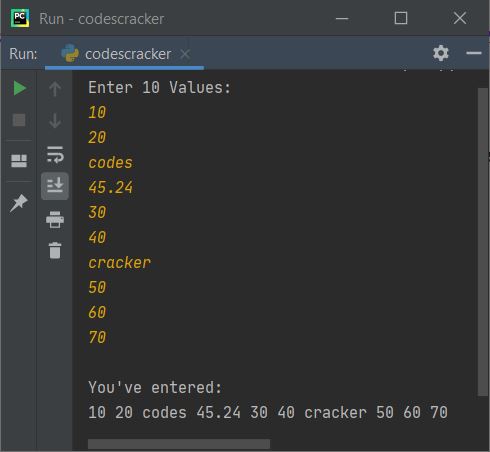
Note - The insert() method inserts an element to the list at desired index number. The first argument specifies as index number, whereas its second argument refers to the value that has to be insert
Note - The range() method returns a sequence of values. By default, it starts with 0 and increments by 1 each time. Continues until the value passed as its argument.
The following statement:
nums = []
states that an empty list is defined. The dry run of following block of code (from above program):
for i in range(10): val = input() nums.insert(i, val)
goes like:
- Initially i=0, since i's value is less than 10, therefore condition evaluates to be true, and program flow goes inside the loop
- Inside the loop, using input(), a value gets received by user and initialized to val variable
- And using the following statement:
nums.insert(i, val)
states that, the value of val variable gets initialized to nums[i] or nums[0] - Now the value of i gets incremented. So i=1, since 1 is less than 10, therefore condition evaluates to be true again, and again program flow goes inside the loop
- Again a value gets received and initialized to val. And the value of val gets stored to nums[i] or nums[1]
- In this way, I've received 10 inputs from user and stores into a list named nums[] one by one
- That is, first number gets stored at nums[0], second at nums[1], third at nums[2], and so on upto tenth at nums[9]
Now print the value of list nums[] using another for loop like shown in the program given above.
To receive only particular type of continuous values like to receive only integer values, then refer to following program:
print("Enter 10 Values: ") nums = [] for i in range(10): while True: try: val = int(input()) nums.insert(i, val) break except ValueError: print("Invalid Input!..Try Again!") continue print("\nYou've entered:") for i in range(10): if i<9: print(nums[i], end=", ") else: print(nums[i])
Here is its sample run with same user input as of previous sample run along with some extra values. Since string and floating-point values treated as invalid ones through above program, therefore in place of those, I've to enter some valid integer values:
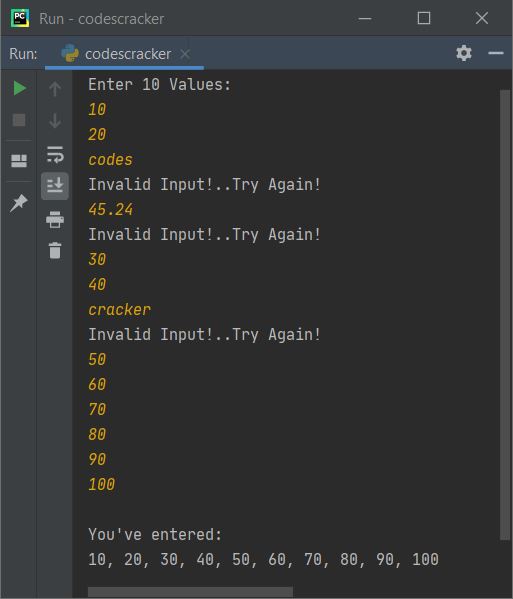
Receive Continuous User Inputs of Given Size
This program allows user to enter the size and values both. For example, if user enters 8 as size, then allows to enter any 8 values.
print("How many values to enter ? ", end="") try: tot = int(input()) print("Enter " +str(tot)+ " Values: ", end="") mylist = [] for i in range(tot): mylist.append(input()) print("\nYou've entered:") for i in range(tot): if i<(tot-1): print(mylist[i], end=", ") else: print(mylist[i]) except ValueError: print("\nInvalid Input!")
Here is the last sample run of this article with 5 as size of values to enter, and 11, 22, 33, 44, 55 as five numbers:
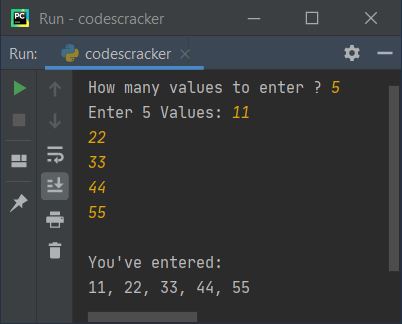
Same Program in Other Languages
« Previous Program Next Program »